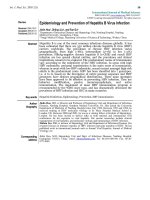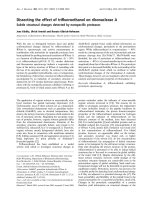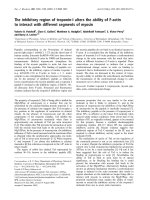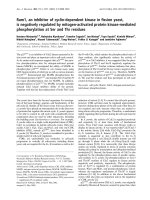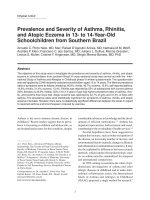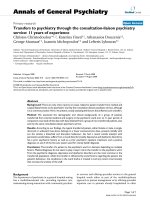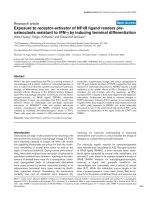Báo cáo y học: "κ Exposure to receptor-activator of NFκB ligand renders preγ osteoclasts resistant to IFN-γ by inducing terminal differentiation'''' pdf
Bạn đang xem bản rút gọn của tài liệu. Xem và tải ngay bản đầy đủ của tài liệu tại đây (1.32 MB, 11 trang )
Introduction
Osteoclasts are large, multinucleated bone-resorbing cells
derived from the monocyte–macrophage lineage [1]. Their
bone-resorbing capacity is unique; no other cell shares
this capability. Osteoclasts are critical for both the contin-
uous remodeling of normal bone tissue as well as the
repair of fractured bones [2]. During normal bone remod-
eling, osteoclast-mediated bone resorption is balanced by
osteoblast-mediated bone formation, resulting in the main-
tenance of skeletal bone mass. As a consequence, osteo-
clast dysregulation leads to osteoporosis (decreased
bone mass caused by excess osteoclast activity) or to
osteopetrosis (increased bone mass caused by insuffi-
cient osteoclast activity). Considering the tremendous
morbidity and cost of metabolic bone diseases [3],
improving our molecular understanding of osteoclast
development and function is critical towards the design of
therapies to combat these prevalent diseases.
The molecular signals required for osteoclastogenesis
have recently been elucidated [1,4,5]. Receptor-activator
of NFκB ligand (RANKL), a tumor necrosis factor super-
family ligand expressed by stromal cells, osteoblasts, and
activated T cells, binds to its cognate receptor-activator of
NFκB (RANK) receptor on macrophages/monocytes,
inducing a signal that gradually transforms the
macrophages into osteoclasts over a period of several
days [6,7]. While this interaction occurs largely in the
bone microenvironment, it has been shown that mono-
cytes from the spleen, peripheral blood, and synovium are
BSA = bovine serum albumin; DMEM = Dulbecco’s modified Eagle’s medium; FACS = fluorescence-activated cell sorting; Fc = crystallizable
fragment; FITC = fluorescein isothiocyanate; IFN = interferon; IL = interleukin; MHC = major histocompatibility complex; NF = nuclear factor; NO =
nitric oxide; RANK = receptor-activator of NFκB; RANKL = receptor-activator of NFκB ligand; Th = T helper cells; TRAP = tartrate-resistant acid
phosphatase.
Available online />Research article
Exposure to receptor-activator of NF
κκ
B ligand renders pre-
osteoclasts resistant to IFN-
γγ
by inducing terminal differentiation
Willis Huang
1
, Regis J O’Keefe
2
and Edward M Schwarz
2
1
The Department of Microbiology and Immunology, University of Rochester Medical Center, Rochester, NY, USA
2
The Center for Musculoskeletal Research, University of Rochester Medical Center, Rochester, NY, USA
Corresponding author: Edward M Schwarz (e-mail: )
Received: 13 August 2002 Revisions received: 11 October 2002 Accepted: 14 October 2002 Published: 13 November 2002
Arthritis Res Ther 2003, 5:R49-R59 (DOI 10.1186/ar612)
© 2003 Huang et al., licensee BioMed Central Ltd (Print ISSN 1478-6354; Online ISSN 1478-6362). This is an Open Access article: verbatim
copying and redistribution of this article are permitted in all media for any non-commercial purpose, provided this notice is preserved along with the
article's original URL.
Abstract
While it has been established that IFN-γ is a strong activator of
macrophages and a potent inhibitor of osteoclastogenesis in
vitro, it is also known that this cytokine is produced in particular
settings of inflammatory bone loss, such as infection and
psoriatic arthritis. Because of the different kinetics between
rapid IFN-γ macrophage activation (< 24 hours) and the slower
receptor-activator of NFκB ligand (RANKL) osteoclast
differentiation (7 days), we postulated that IFN-γ would have
different effects on early-stage and late-stage osteoclast
precursors. In RAW264.7 cells and primary splenocyte
cultures, pretreatment with RANKL rendered these cells
resistant to maximally anti-osteoclastogenic doses of IFN-γ.
These cells were also resistant to IFN-γ-induced nitric oxide
production, morphological change, and surface upregulation of
CD11b and receptor-activator of NFκB, suggesting that early
exposure of osteoclast precursors to RANKL induces a broad
resistance to the cellular effects of IFN-γ. Changes in STAT1
activation did not correlate with this resistance, as IFN-γ
activated STAT1 equally in both early-stage and late-stage pre-
osteoclasts. Furthermore, we failed to observe changes in
TRAF6 expression following IFN-γ treatment in pre-osteoclasts.
Together these data support a model of inflammatory bone loss
in which early exposure to RANKL can prime osteoclast
precursors to form in the presence of high levels of IFN-γ using
mechanisms independent of the signal molecules STAT1 and
TRAF6.
Keywords: cellular differentiation, cytokines, monocytes/macrophages
Open Access
R49
R50
Arthritis Research and Therapy Vol 5 No 1 Huang et al.
all capable of RANKL-dependent osteoclast formation [8].
Convincing evidence has been generated indicating that
the RANK–RANKL interaction is absolutely required for
osteoclastogenesis [7]; in the absence of these mole-
cules, osteoclastogenesis cannot occur [9].
While the RANK–RANKL signal is absolutely required for
osteoclastogenesis, the efficiency of this process is influ-
enced by cytokines. The proinflammatory cytokines tumor
necrosis factor alpha, IL-1, and IL-6 augment osteoclasto-
genesis [9–11], while IL-10, IL-12, IL-18, and IFN-γ anta-
gonize osteoclastogenesis in vitro [12–15]. It is probable
that cytokines play a vital role in the delicate balance of
bone remodeling, and that therapies based upon their
natural biological function can be designed.
IFN-γ is a cytokine secreted primarily by activated T cells
and NK cells whose role in bone biology is only beginning
to be clarified. It was originally characterized as a powerful
macrophage activator that upregulated nitric oxide (NO)
production and MHC expression in macrophages [16]. It
has since been shown to stimulate antiviral and antibacter-
ial activities, to differentiate Th0 cells toward Th1 fates,
and to activate endothelial cells for leukocyte adhesion
(reviewed in [17,18]).
With respect to osteoclast formation, IFN-γ is known to
potently inhibit RANKL-mediated osteoclastogenesis in
both spleen-derived macrophage cultures and bone
marrow coculture systems [19–21]. It has also been
demonstrated that mice defective in IFN-γ signaling have a
more rapid onset of arthritis and bone resorption com-
pared with wild-type mice, suggesting a protective role of
IFN-γ in early arthritis [21,22].
There are situations, however, in which the anti-osteo-
clastogenic effects of IFN-γ are not so clear. While IFN-γ is
not highly expressed in joints of patients with rheumatoid
arthritis, diseases such as erosive tuberculoid leprosy
[23,24] and psoriatic arthritis [25] are associated with
high Th1 cytokines such as IFN-γ [26]. In these conditions,
tissue destruction has been shown to correlate with Th1-
mediated immune responses and the production of IFN-γ,
indicating that osteoclastogenesis may occur in the pres-
ence of elevated IFN-γ [27].
Furthermore, several clinical studies have failed to
demonstrate efficacy of IFN-γ administration as an anti-
osteoclastogenic agent to prevent bone loss [28–30].
There seem to be situations in which IFN-γ does not act as
an anti-osteoclastogenic agent. In particular, IFN-γ has
been shown to be efficacious in the treatment of osteo-
petrosis in humans [31].
In the present study, we demonstrate that early exposure
to RANKL renders osteoclast precursors resistant to the
effects of IFN-γ, including inhibition of osteoclastogenesis.
These effects were irreversible and not caused by inhibi-
tion of proximal signaling at the level of STAT1 or TRAF6,
suggesting that resistance to IFN-γ is caused by a
complex differentiation program specifying the osteoclast
fate. These data may help explain the contradictory find-
ings regarding the effects of IFN-γ as an inhibitor of osteo-
clastogenesis, and also suggest a model of erosive
disease in the presence of IFN-γ whereby osteoclast pre-
cursors are exposed to RANKL before they enter the
IFN-γ-rich environment.
Materials and methods
Cytokines and growth factors
Murine IFN-γ, macrophage colony-stimulating factor, tumor
necrosis factor alpha, IL-1, IL-10 and IL-6 were obtained
from R&D Systems (Minneapolis, USA). GST-mRANKL
was generated as described later. Human RANKL was a
gift from Immunex (Seattle, USA) and was used to verify
the efficiency of GST-RANKL protein as verified by splenic
osteoclast induction.
Cell culture and animals
The RAW264.7 mouse macrophage cell line was obtained
from ATCC (Manassas, USA) and grown in a humidified
5% CO
2
environment at 37°C. Cultures were maintained
with DMEM (R&D Systems) supplemented with 10% fetal
bovine serum and 1% penicillin/streptomycin. RAW cell
osteoclasts were generated by plating exactly 5000 RAW
cells per well in a 96-well dish with 200 ng/ml GST-RANKL
or additional cytokines and culturing for 4–5 days. In some
cultures, administration of IFN-γ was delayed to allow for an
early effect of RANKL. Osteoclasts were large, multinucle-
ated cells, and expressed high levels of tartrate-resistant
acid phosphatase (TRAP). For western blots, RAW cells
were grown in six-well dishes at 100,000 cells/well with
the same cytokine treatments.
CBA/BL6 mice (Jackson Labs, Bar Harbor, USA) were
sacrificed at 6–8 weeks and spleens aseptically removed.
Splenocytes were mechanically dissociated by disruption
through steel mesh, and red blood cells were lysed using
a hypotonic ammonium chloride solution (82.9 g ammo-
nium chloride, 10 g potassium bicarbonate, 0.37 g EDTA,
1 l sterile water for a 10× solution). The remaining white
cells were plated in 96-well plates at 200,000 cells/well
with 50 ng/ml murine macrophage colony-stimulating
factor (R&D Systems) to preferentially maintain monocyte
proliferation. Large, multinucleated, TRAP
+
osteoclasts
were generated by further addition of 200 ng/ml GST-
RANKL and culturing for 4–6 days. IFN-γ (10 ng/ml) was
added on various days in some cultures.
TRAP staining and quantitation
Cultures were stained with the osteoclast-specific marker
TRAP using a kit from Sigma (St Louis, USA). In osteo-
R51
clast precursors, RANKL induced increasing TRAP
expression until virtually 100% of mononuclear cells were
highly TRAP-positive. Fusion and multinucleation subse-
quently occurred in proportion to the magnitude of the
RANKL stimulus.
Osteoclasts were counted using three equivalent
methods, optimized for the extent of osteoclastogenesis.
For extremely robust osteoclast cultures, manual tracing
and digital quantitation of a photographed osteoclast area
was the best measure due to extensive fusion and multi-
nucleation between cells (Fig. 1). Less robust cultures
with 80–150 osteoclasts per well were more accurately
quantitated by counting individual osteoclasts (Fig. 2). For
cultures utilizing lower levels of RANKL and low osteoclast
numbers, densitometric quantitation of TRAP was a more
sensitive measure of osteoclastogenesis (Fig. 2d).
Purification of GST-RANKL
GST-RANKL was purified as described previously [32].
Briefly, a fragment of murine RANKL cDNA was cloned
inframe into the pGEX-4T vector (Amersham Pharmacia,
Piscataway, USA) and expressed in BL21 bacteria (Amer-
sham Pharmacia) induced with 0.1 mM IPTG (Gibco) for
5 hours at 30°C. Bacteria were lysed, and soluble proteins
were recovered using glutathione-agarose beads (Amer-
sham Pharmacia). Protein purity was assessed by SDS-
PAGE with Coomassie Blue by comparison with 99%
pure BSA standards (Sigma) and shown to of equivalent
purity (Fig. 1a). The bioactivity of GST-RANKL was verified
by RAW cell osteoclastogenesis and TRAP expression
before experimental use. A dose of 200 ng/ml GST-
RANKL had equivalent bioactivity to 100 ng/ml eukaryoti-
cally expressed human RANKL protein (donated by
Immunex).
NO measurement
NO production was measured by the Greiss reaction
(Promega, Madison, USA), which spectrophotometrically
detects nitrite, a stable breakdown product of NO whose
accumulation reflects NO production. RAW cells were
plated in 96-well plates, and were stimulated with GST-
RANKL (200 ng/ml) and/or IFN-γ (10 ng/ml). Cell super-
natants were harvested and reacted with 1% sulfanilamide
and 0.1% naphthyl-ethylenediamine. A standard curve was
constructed using dilutions of sodium nitrite, and the
absorbance was measured at 550 nm. Similar data were
obtained from protein-normalized data to control for varia-
tion in cell number or proliferation.
Western blotting
Cells were lysed with hypotonic lysis buffer with protease
inhibitors (Roche/Boehringer Mannheim, Indianapolis,
USA). Thirty micrograms of cytoplasmic lysates or 20 µg
nuclear lysates were loaded onto 12% SDS-PAGE gels
and immunoblotted using chemiluminescent antibodies.
Short exposures of blots were also performed to verify that
signals shown did not result from blot overexposure. All
antibodies were from Santa Cruz (Santa Cruz, USA)
except anti-actin, which was purchased from Sigma.
Flow cytometry
After red blood cell lysis, a single cell suspension was
incubated with antimurine CD16/32 (Pharmingen, San
Diego, USA) to block Fc receptor-mediated antibody
binding. Cells were then labeled with phycoerythrin-conju-
gated anti-CD11b antibodies (Pharmingen) or fluorescein-
conjugated RANKL (a gift from M Tondravi, American Red
Cross, Rockville, MD, USA) as described previously [33].
Data were acquired using a FACScalibur instrument
(Beckton Dickenson, Bedford, MA, USA) and were ana-
lyzed by Cellquest software (version 3.1, Beckton Dicken-
son). CD11b expression followed a normal-type
distribution in all groups indicative of one population, and
the mean fluorescent intensity was thus the unit of
measure. RANK staining indicated two populations, and
the relative size of the high RANK expressing (RANKhi)
population was thus expressed on a percentage basis.
Available online />Figure 1
Receptor-activator of NFκB ligand (RANKL) induces osteoclastogenesis in RAW264 cells. (a) Bacterially produced GST-RANKL protein was
purified and visualized with SDS-PAGE/Coomassie Blue against 99% pure BSA standards. (b) RAW cells were cultured with the indicated doses
of GST-RANKL for 4 days and then stained for tartrate-resistant acid phosphatase.
Results
IFN-
γγ
potently and irreversibly inhibits RANKL-induced
osteoclastogenesis
To evaluate the effects of IFN-γ on osteoclastogenesis, we
utilized the mouse macrophage cell line RAW264.7 (RAW
cells) or splenic macrophages from CBA/BL6 mice as
osteoclast precursors. These cells have been demon-
strated to recapitulate critical aspects of osteoclast forma-
tion and activity, including bone resorption, expression of
calcitonin receptor, multinuclear fusion, and TRAP expres-
sion [6,34].
A dose of 200 ng/ml RANKL generated numerous large,
multinucleated osteoclasts. Lower doses induced the
osteoclast-specific marker TRAP in mononuclear cells but
generated substantially fewer osteoclasts (Fig. 1a,b). A
24-hour exposure to IFN-γ was sufficient to potently and
irreversibly inhibit osteoclastogenesis in the presence of
maximal doses of RANKL (Fig. 2). The exposure also
induced a stellate cellular morphology consistent with that
of an activated macrophage (Fig. 2). The rapid and irre-
versible effects of IFN-γ on osteoclast inhibition indicate a
dominant effect of this cytokine over RANKL via induction
of monocyte differentiation toward the activated
macrophage fate, as opposed to the osteoclast fate, when
concomitantly administered.
RANKL-pretreated RAW cells are resistant to the anti-
osteoclastogenic effect of IFN-
γγ
The different kinetics between IFN-γ-mediated macro-
phage activation (< 24 hours) and RANKL-medicated
osteoclastogenesis (4–5 days) prompted us to investigate
the effects of IFN-γ on RANKL-pretreated cells (Fig. 3).
Pretreatment of RAW cells with RANKL for 48 hours ren-
dered them resistant to IFN-γ; these mononuclear cells
formed multinuclear osteoclasts despite the presence of
maximally inhibitory doses of IFN-γ (10 ng/ml).
To characterize this RANKL-mediated resistance to IFN-γ,
we performed a series of dose–response and time course
experiments. Pretreatment with lower doses of RANKL
was unable to overcome IFN-γ inhibition, indicating that
Arthritis Research and Therapy Vol 5 No 1 Huang et al.
R52
Figure 2
IFN-γ dominantly inhibits receptor-activator of NFκB ligand (RANKL)-mediated osteoclastogenesis. (a) RAW cells received the indicated cytokine
treatments of IFN-γ (10 ng/ml) and/or RANKL (200 ng/ml). Cells were stained for the osteoclast marker tartrate-resistant acid phosphatase (TRAP)
on day 5 and osteoclast numbers were counted; a 1x micrograph of a representative well is shown above its corresponding column. TRAP
positivity and osteoclast formation are seen only in the absence of IFN-γ. (b)–(e) Micrographs (10×) of the same groups show that IFN-γ stimulates
a stellate morphology and inhibits osteoclastogenesis. All panels represent continuous cytokine treatment, except for the IFN-γ washout group (e).
OC, osteoclast.
resistance to IFN-γ required high levels of RANKL pre-
treatment (Fig. 4a,b). The duration of RANKL pretreatment
was also important; the longer the pretreatment phase, the
greater the resistance to IFN-γ (Fig. 4c). Together these
data show that pretreatment with RANKL increases resis-
tance to IFN-γ-mediated osteoclast inhibition in a dose-
dependent and time-dependent manner.
The mechanism by which IFN-γ and RANKL reciprocally
inhibit each other in pre-osteoclasts is independent of
TRAF-6 and STAT1 signal transduction. Since it is well
Available online />R53
Figure 3
Pretreatment with receptor-activator of NFκB ligand (RANKL) permits
osteoclastogenesis in the presence of maximally inhibitory IFN-γ in a
dose-dependent and time-dependent manner. RAW cells were grown
in the presence of continuous RANKL (100 ng/ml) for 4 days, in the
absence or presence of IFN-γ as indicated on either day 0 or 2 of
culture. (a) Representative photographs from each group are shown at
10× magnification, and (b) the average number of osteoclasts per well
± SEM is presented. (c), (d) The experiments were repeated with
primary osteoclast precursors in splenocyte cultures. For both RAW
cells and primary osteoclast precursors, RANKL pretreatment allowed
for osteoclastogenesis despite the presence of a maximally inhibitory
dose of IFN-γ (10 ng/ml). * P < 0.05 compared with either untreated
controls or cells treated with IFN-γ for the whole culture period.
Figure 4
Osteoclast formation in the presence of IFN-γ depends upon receptor-
activator of NFκB ligand (RANKL) pretreatment in a dose-dependent
and time-dependent manner. (a) RAW cells were pretreated with the
indicated doses of RANKL for 2 days. On day 3, cells were switched
to media with RANKL (200 ng/ml GST-RANKL) and various doses of
IFN-γ, were then fixed and tartrate-resistant acid phosphatase (TRAP)
stained after day 4. (b) The mean ± SEM of three independent
experiments containing the highest dose of IFN-γ in (a) with statistics. *
P = 0.05 compared with RANKL pretreatment at 0 ng/ml. (c) RAW
cells treated continuously with a suboptimal dose of GST-RANKL
(50 ng/ml), to slow osteoclastogenesis, were given IFN-γ (10 ng/ml) at
the indicated time points. All cells were fixed and stained for TRAP on
day 6. TRAP staining was quantitated densitometrically as described in
Materials and methods. RANKL-treated RAW cells (no IFN-γ) stained
on day 2 were only 10–20% TRAP-positive. All cultures with RANKL
pretreatment ≥ 24 hours underwent osteoclastogenesis. * P = 0.05
compared with the IFN-γ day 0 group.
established that RANK signaling is mediated primarily
through TRAF6 [35] and that IFN-γ signaling is mediated
primarily through STAT1 [36,37], we examined their
expression by western blot. We failed to observe signifi-
cant degradation of TRAF6 after stimulation with IFN-γ or
RANKL in short-term or long-term cultures (Fig. 5a,b).
Interestingly, IFN-γ-induced STAT1 phosphorylation and
nuclear translocation was retained in pre-osteoclasts
(Fig. 5c). This result was confirmed by electrophoretic
mobility shift assays and the absence of detectable
amounts of the STAT1 antagonists SOCS1 and SOCS3
(data not shown). These results show that late pre-osteo-
clasts are capable of signaling via JAK-STAT1, and
suggest that signaling events distal to TRAF6 and STAT1
modulate the resistance of these cells to IFN-γ.
RANKL pretreatment inhibits IFN-
γγ
-induced
macrophage activation
We next investigated whether other IFN-γ effects besides
osteoclast inhibition were blunted in RANKL-pretreated
cells. IFN-γ-induced NO production in macrophages was
blunted in osteoclasts, probably due to specialization for
Arthritis Research and Therapy Vol 5 No 1 Huang et al.
R54
Figure 5
TRAF6 levels and STAT1 signaling are intact in late pre-osteoclasts.
(a) Untreated RAW cells were stimulated with IFN-γ for 5, 15 and
60 min, and then protein extracts were analyzed by immunoblotting as
described in Materials and methods. Multiple signals were achieved by
stripping and reprobing the same blot. TRAF6 expression increased
with IFN-γ signaling. (b) RAW cells were cultured for 4 days in the
presence of the indicated cytokines. Osteoclasts were observed in the
receptor-activator of NFκB ligand (RANKL) group, while activated
macrophages were observed in the RANKL + IFN-γ group similar to that
described in the previous experiments. TRAF6 expression was
remarkably consistent in these cells. (c) Nuclear extracts were prepared
from untreated RAW cells and late pre-osteoclasts (treated with
RANKL for 2 days) and immunoblotted with antiphospho-Stat1
antibodies to assess nuclear translocation in extracts obtained at the
indicated time points following IFN-γ treatment. Late pre-osteoclasts
translocated phospho (p)-Stat1 as well as untreated RAW cells.
Figure 6
Receptor-activator of NFκB ligand (RANKL) pretreatment impairs
IFN-γ-induced nitric oxide (NO) production in a dose-dependent
manner. (a) RAW cells were treated as in Figure 2a, and supernatants
assayed for NO production on day 4. NO production was significantly
inhibited by pretreatment with RANKL (* P < 0.01 versus the IFN-γ
only group). (b) RAW cells were grown in the presence of various
doses of RANKL, then supplemented with various doses of IFN-γ and
maximal GST-RANKL (200 ng/ml) on day 2. NO was assayed on
day 4. Black bars indicate cells treated on day 2 with 100 ng/ml IFN-γ.
(c) This group (indicated by black bars) with statistics. Inhibition of NO
production by RANKL pretreatment is dose dependent, with more
inhibition with higher doses of RANKL (* P < 0.05 versus 0 ng/ml
RANKL).
bone resorption in the latter differentiated cell (Fig. 6). Pre-
treatment with RANKL inhibited IFN-γ-induced NO pro-
duction in a dose-dependent and time-dependent manner
(Fig. 6b,c).
To expand these findings, we investigated the regulation
of the cell surface markers CD11b and RANK in response
to induction by RANKL and IFN-γ (Fig. 7). Both markers
were strongly upregulated by IFN-γ. Consistent with our
Available online />R55
Figure 7
Late pre-osteoclasts are resistant to IFN-γ-induced surface expression of CD11b and receptor-activator of NFκB (RANK). (a) Cells were treated
with the indicated cytokines for 4 days, then analyzed for CD11b expression by FACS. Late pre-osteoclasts (RAW cells pretreated with 200 ng/ml
receptor-activator of NFκB ligand [RANKL] for 2 days prior to IFN-γ treatment) expressed CD11b at levels nearly identical to RANKL-only treated
cells, suggesting that late pre-osteoclasts are resistant to IFN-γ-induced CD11b upregulation. (b) Identically treated cells were analyzed for RANK
expression by FACS. The proportion of RANKhi cells was nearly identical in RANKL-only treated cells and late pre-osteoclasts, suggesting that late
pre-osteoclasts are resistant to IFN-γ-induced upregulation of RANK. MFI, mean fluorescence intensity.
prior results, concomitant treatment of IFN-γ and RANKL
showed dominance of the IFN-γ upregulation, while pre-
treatment with RANKL for 2 days showed impaired upreg-
ulation. These data support the hypothesis that sensitivity
to IFN-γ decreases with increasing osteoclast differentia-
tion and that the mechanism by which RANKL and IFN-γ
reciprocally inhibit each other in pre-osteoclasts is mediat-
ing the irreversible commitment into the osteoclast or acti-
vated macrophage lineages.
Discussion
The role of cellular immunity (Th1) in inflammatory bone
loss such as that seen in osteomyelitis and erosive arthritis
remains unclear. The resolution of this issue is further
clouded by the apparent contradictory findings that IFN-γ
is an extremely potent anti-osteoclastogenic factor [38]
but it can be found at high levels in sites of osteolysis [39].
To reconcile this controversy we performed a series of
experiments aimed at understanding how IFN-γ could
induce either bactericidal effects via macrophage activa-
tion or osteoclastic bone resorption, by influencing the
same progenitor cell in the same bone environment.
We demonstrate that pre-osteoclasts stimulated with
RANKL for 2 days are rendered resistant to the IFN-γ-
induced inhibition of osteoclastogenesis, NO production,
and upregulation of CD11b and RANK surface
expression. Surprisingly, this resistance is not mediated by
inhibition of the JAK-STAT1 pathway, as STAT1
phosphorylation, nuclear translocation, and DNA-binding
capabilities are all preserved in the late pre-osteoclast.
Together this evidence suggests that RANKL modifies
IFN-γ effects downstream of STAT1.
The present results predict that timing of IFN-γ exposure
will be an important determinant of its biological function
during in vivo osteoclastogenesis. In the case of circulat-
ing or peripheral macrophages that have not encountered
osteoclastogenic quantities of RANKL, IFN-γ rapidly
induces macrophage activation and subsequent NO pro-
duction, recruiting these cells for immune responses. The
dominance of IFN-γ over RANKL, which we observed in
vitro (1 ng IFN-γ counteracts 200 ng RANKL when simul-
taneously administered), probably allows this macrophage
activation to occur even in the presence of RANKL
expressed on circulating, activated T cells [20,40]. In the
bone microenvironment, however, more abundant RANKL
produced by osteoblasts/stromal cells may influence
certain monocytes to commit to the osteoclast lineage
[41,42].
The present results predict that IFN-γ will not activate
these cells, as they have received an early RANKL signal.
The strength of the early RANKL signal may be altered in
the setting of inflammatory bone diseases such as
rheumatoid arthritis, in which high levels of RANKL
expressed on either synovial cells or infiltrating T cells
[43,44] may induce osteoclast formation despite the pres-
ence of exogenous or endogenous IFN-γ.
The potency of IFN-γ as a macrophage activator and
osteoclast inhibitor suggests a prominent role for T cells
and/or NK cells in the regulation of bone resorption, as
these cells constitute the major source of IFN-γ [18]. A link
between activated T cells and osteoclast inhibition by
IFN-γ has been highlighted in a report by Takayanagi et al.,
providing the first in vivo evidence that the immune system
may influence osteoclastogenesis [38]. Interestingly, other
groups have demonstrated that activated T cells induce
osteoclastogenesis via upregulation of surface RANKL,
presenting a dilemma regarding the role of activated
T cells in osteoclastogenesis [20,40,45].
It is possible that RANKL and IFN-γ expression by acti-
vated T cells may be a major mechanism by which T cells
control the fate of osteoclasts, and that relative expression
of both molecules will dictate whether osteoclasts are
induced or inhibited. The present results suggest that the
influence of activated T cells on osteoclasts will probably
change depending on when and where the T cells
encounter the osteoclasts. Bone-resident macrophages
pre-exposed to RANKL in the stromal environment may be
resistant to the immunoregulatory effects of IFN-γ, and
may thus be better suited for bone-remodeling tasks. In
contrast, peripheral blood macrophages not exposed to
RANKL may be more responsive to the macrophage-
activating immunoregulatory effects of IFN-γ, and may thus
be better suited for antimicrobial activities.
The molecular mechanisms underlying the contrasting
effects of IFN-γ and RANKL remain elusive. Based on the
phenotype of knockout mice, it has become clear that
TRAF6 is the critical adapter molecule required for RANK
signaling during osteoclastogenesis [35]. The importance
of TRAF6 has been further explored in deletion studies,
which correlated its various domains with its osteoclasto-
genic potential [46]. A link between IFN-γ and RANK sig-
naling via TRAF6 has also been demonstrated in bone
marrow cultures, in which IFN-γ was shown to accelerate
the degradation of TRAF6 [38]. In our studies, however,
we failed to observe this TRAF6 degradation, as its
expression remained constant in both short-term and long-
term cultures under conditions where IFN-γ completely
inhibited osteoclastogenesis. While this discrepancy
could be explained by the possibility that RAW cells repre-
sent a stage of pre-osteoclast differentiation that is not
sensitive to IFN-γ-mediated TRAF6 degradation, the
present studies clearly indicate that IFN-γ can inhibit
osteoclastogenesis via a completely different mechanism.
The retention of Jak-STAT1 signaling in RANKL-stimulated
pre-osteoclasts is intriguing, given their demonstrated
Arthritis Research and Therapy Vol 5 No 1 Huang et al.
R56
insensitivity to IFN-γ. Since it is known that osteoclasts
express IFN-γ receptors [47,48], it begs the question as to
why this pathway remains operant. One possibility is that
IFN-γ-induced STAT1 activation in osteoclasts leads to the
expression of a unique set of genes that is distinct from
that in macrophages. Future studies designed to under-
stand IFN-γ signaling in mature osteoclasts are needed to
resolve this issue.
It is noteworthy to point out that the dominant/irreversible
inhibitory effects of IFN-γ on osteoclastogenesis are fun-
damentally different to the transient/reversible inhibitory
effects of IL-4 on this process, which are mediated by
STAT6 inhibition of NFκB activation [49,50]. In the
present article, we demonstrate that RANKL-induced
osteoclastogenesis cannot be recovered following expo-
sure to IFN-γ. In contrast, Wei et al. have demonstrated
that pre-osteoclasts do not lose their potential to differen-
tiate into mature osteoclasts following a similar exposure
to IL-4 [50]. It thus appears that IFN-γ anti-osteoclast
activity is mediated by inducing terminal differentiation
away from the osteoclast lineage, while IL-4 directly inter-
feres with RANKL signaling during osteoclastogenesis.
Collectively, these findings are consistent with the obser-
vations that Th1 cells are associated with erosive disease
[39,50,51], that IFN-γ does not have antiresorptive activity
[52–54], and that IL-4 inhibits bone resorption [55–57].
The present results underscore the importance of devel-
oping a complete understanding of osteoclastogenesis in
vivo with regard to location, time, and the signal transduc-
tion pathways involved. It is probable that signals such as
IFN-γ will be interpreted differently by precursors at
various stages of development, with consequent effects
on disease. Future studies in this area are needed to
better understand how T cells producing both IFN-γ and
RANKL mediate immunity and bone resorption, and to
better elucidate their role in the pathogenesis of diseases
such as osteomyelitis and erosive arthritis.
Conclusion
We have demonstrated, using in vitro methods, that
osteoclast precursors exposed to RANKL for 1–2 days
can be rendered resistant to maximal osteoclast-inhibitory
doses of IFN-γ. These IFN-γ-resistant pre-osteoclasts pro-
duced low levels of NO upon IFN-γ stimulation and were
resistant to IFN-γ-induced, Mac-1-induced and RANKL-
induced surface expression, suggesting a broad resis-
tance to the cellular effects of IFN-γ. The Jak-Stat1
pathway was intact in these cells, indicating that down-
stream transcriptional events are involved in the inhibition.
These results imply a model for arthritic joints in which
macrophage precursors entering an inflamed joint are
exposed to RANKL and are subsequently rendered resis-
tant to the anti-osteoclastogenic effects of IFN-γ
expressed by activated T cells in the synovium.
Acknowledgements
WH was supported by the National Institutes of Health, National
Research Service Award GM-07356 from the National Institute of
General Medical Sciences, Medical Scientist Training Grant. RJO and
EMS were supported by grants for the National Institutes of Health
(PHS AR45791 and AR44220).
References
1. Teitelbaum SL: Bone resorption by osteoclasts. Science 2000,
289:1504-1508.
2. Childs LM, Goater JJ, O’Keefe RJ, Schwarz EM: Efficacy of etan-
ercept for wear debris-induced osteolysis. J Bone Miner Res
2001, 16:338-347.
3. Arthritis Foundation [ />Center/ra.asp].
4. Suda T, Kobayashi K, Jimi E, Udagawa N, Takahashi N: The mole-
cular basis of osteoclast differentiation and activation. Novar-
tis Found Symp 2001, 232:235-247.
5. Hofbauer LC, Khosla S, Dunstan CR, Lacey DL, Boyle WJ, Riggs
BL: The roles of osteoprotegerin and osteoprotegerin ligand
in the paracrine regulation of bone resorption. J Bone Miner
Res 2000, 15:2-12.
6. Kong YY, Yoshida H, Sarosi I, Tan HL, Timms E, Capparelli C,
Morony S, Oliveira-dos-Santos AJ, Van G, Itie A, Khoo W,
Wakeham A, Dunstan CR, Lacey DL, Mak TW, Boyle WJ, Pen-
ninger JM: OPGL is a key regulator of osteoclastogenesis,
lymphocyte development and lymph-node organogenesis.
Nature 1999, 397:315-323.
7. Lacey DL, Timms E, Tan HL, Kelley MJ, Dunstan CR, Burgess T,
Elliott R, Colombero A, Elliott G, Scully S, Hsu H, Sullivan J,
Hawkins N, Davy E, Capparelli C, Eli A, Qian YX, Kaufman S,
Sarosi I, Shalhoub V, Senaldi G, Guo J, Delaney J, Boyle WJ:
Osteoprotegerin ligand is a cytokine that regulates osteoclast
differentiation and activation. Cell 1998, 93:165-176.
8. Yasuda H, Shima N, Nakagawa N, Yamaguchi K, Kinosaki M,
Mochizuki S, Tomoyasu A, Yano K, Goto M, Murakami A, Tsuda E,
Morinaga T, Higashio K, Udagawa N, Takahashi N, Suda T:
Osteoclast differentiation factor is a ligand for osteoprote-
gerin/osteoclastogenesis-inhibitory factor and is identical to
TRANCE/RANKL. Proc Natl Acad Sci USA 1998, 95:3597-
3602.
9. Lam J, Takeshita S, Barker JE, Kanagawa O, Ross FP, Teitelbaum
SL: TNF-alpha induces osteoclastogenesis by direct stimula-
tion of macrophages exposed to permissive levels of RANK
ligand. J Clin Invest 2000, 106:1481-1488.
10. Mundy GR: Cytokines and Bone Remodeling. San Diego, CA:
Academic Press; 1996.
11. Jimi E, Nakamura I, Duong LT, Ikebe T, Takahashi N, Rodan GA,
Suda T: Interleukin 1 induces multinucleation and bone-
resorbing activity of osteoclasts in the absence of
osteoblasts/stromal cells. Exp Cell Res 1999, 247:84-93.
12. Horwood NJ, Elliott J, Martin TJ, Gillespie MT: IL-12 alone and in
synergy with IL-18 inhibits osteoclast formation in vitro.
J Immunol 2001, 166:4915-4921.
13. Hong MH, Williams H, Jin CH, Pike JW: The inhibitory effect of
interleukin-10 on mouse osteoclast formation involves novel
tyrosine-phosphorylated proteins. J Bone Miner Res 2000, 15:
911-918.
14. Fox SW, Chambers TJ: Interferon-gamma directly inhibits
TRANCE-induced osteoclastogenesis. Biochem Biophys Res
Commun 2000, 276:868-872.
15. Takahashi N, Mundy GR, Roodman GD: Recombinant human
interferon-gamma inhibits formation of human osteoclast-like
cells. J Immunol 1986, 137:3544-3549.
16. OMIM, interferon-gamma listing. NCBI. 14 May 2002 [electronic
citation].
17. Tau G, Rothman P: Biologic functions of the IFN-gamma
receptors. Allergy 1999, 54:1233-1251.
18. Farrar MA, Schreiber RD: The molecular cell biology of inter-
feron-gamma and its receptor. Annu Rev Immunol 1993, 11:
571-611.
19. Takahashi N, Udagawa N, Suda T: A new member of tumor
necrosis factor ligand family, ODF/OPGL/TRANCE/RANKL,
regulates osteoclast differentiation and function. Biochem
Biophys Res Commun 1999, 256:449-455.
Available online />R57
20. Kong YY, Feige U, Sarosi I, Bolon B, Tafuri A, Morony S, Cappar-
elli C, Li J, Elliott R, McCabe S, Wong T, Campagnuolo G, Moran
E, Bogoch ER, Van G, Nguyen LT, Ohashi PS, Lacey DL, Fish E,
Boyle WJ, Penninger JM: Activated T cells regulate bone loss
and joint destruction in adjuvant arthritis through osteoprote-
gerin ligand. Nature 1999, 402:304-309.
21. Vermeire K, Heremans H, Vandeputte M, Huang S, Billiau A,
Matthys P: Accelerated collagen-induced arthritis in IFN-
gamma receptor-deficient mice. J Immunol 1997, 158:5507-
5513.
22. Manoury-Schwartz B, Chiocchia G, Bessis N, Abehsira-Amar O,
Batteux F, Muller S, Huang S, Boissier MC, Fournier C: High sus-
ceptibility to collagen-induced arthritis in mice lacking IFN-
gamma receptors. J Immunol 1997, 158:5501-5506.
23. Arnoldi J, Gerdes J, Flad HD: Immunohistologic assessment of
cytokine production of infiltrating cells in various forms of
leprosy. Am J Pathol 1990, 137:749-753.
24. Desai SD, Birdi TJ, Antia NH: Correlation between macrophage
activation and bactericidal function and Mycobacterium leprae
antigen presentation in macrophages of leprosy patients and
normal individuals. Infect Immun 1989, 57:1311-1317.
25. Firestein GS, Alvaro-Gracia JM, Maki R, Alvaro-Garcia JM: Quan-
titative analysis of cytokine gene expression in rheumatoid
arthritis. J Immunol 1990, 144:3347-3353.
26. Ritchlin C, Haas-Smith SA, Hicks D, Cappuccio J, Osterland CK,
Looney RJ: Patterns of cytokine production in psoriatic syn-
ovium. J Rheumatol 1998, 25:1544-1552.
27. Park SH, Min DJ, Cho ML, Kim WU, Youn J, Park W, Cho CS, Kim
HY: Shift toward T helper 1 cytokines by type II collagen-reac-
tive T cells in patients with rheumatoid arthritis. Arthritis
Rheum 2001, 44:561-569.
28. Cannon GW, Pincus SH, Emkey RD, Denes A, Cohen SA, Wolfe
F, Saway PA, Jaffer AM, Weaver AL, Cogen L, et al.: Double-
blind trial of recombinant gamma-interferon versus placebo in
the treatment of rheumatoid arthritis. Arthritis Rheum 1989,
32:964-973.
29. Veys EM, Mielants H, Verbruggen G, Grosclaude JP, Meyer W,
Galazka A, Schindler J: Interferon gamma in rheumatoid arthri-
tis — a double blind study comparing human recombinant
interferon gamma with placebo. J Rheumatol 1988, 15:570-
574.
30. Veys EM, Menkes CJ, Emery P: A randomized, double-blind
study comparing twenty-four-week treatment with recombi-
nant interferon-gamma versus placebo in the treatment of
rheumatoid arthritis. Arthritis Rheum 1997, 40:62-68.
31. Key LL, Jr., Rodriguiz RM, Willi SM, Wright NM, Hatcher HC, Eyre
DR, Cure JK, Griffin PP, Ries WL. Long-term treatment of
osteopetrosis with recombinant human interferon gamma. N
Engl J Med 1995, 332:1594-1599.
32. Lam J, Nelson CA, Ross FP, Teitelbaum SL, Fremont DH: Crystal
structure of the TRANCE/RANKL cytokine reveals determi-
nants of receptor-ligand specificity. J Clin Invest 2001, 108:
971-979.
33. Anderson DM, Maraskovsky E, Billingsley WL, Dougall WC,
Tometsko ME, Roux ER, Teepe MC, DuBose RF, Cosman D, Gal-
ibert L: A homologue of the TNF receptor and its ligand
enhance T-cell growth and dendritic-cell function. Nature
1997, 390:175-179.
34. Hsu H, Lacey DL, Dunstan CR, Solovyev I, Colombero A, Timms
E, Tan HL, Elliott G, Kelley MJ, Sarosi I, Wang L, Xia XZ, Elliott R,
Chiu L, Black T, Scully S, Capparelli C, Morony S, Shimamoto G,
Bass MB, Boyle WJ: Tumor necrosis factor receptor family
member RANK mediates osteoclast differentiation and activa-
tion induced by osteoprotegerin ligand. Proc Natl Acad Sci
USA 1999, 96:3540-3545.
35. Lomaga MA, Yeh WC, Sarosi I, Duncan GS, Furlonger C, Ho A,
Morony S, Capparelli C, Van G, Kaufman S, van der Heiden A, Itie
A, Wakeham A, Khoo W, Sasaki T, Cao Z, Penninger JM, Paige
CJ, Lacey DL, Dunstan CR, Boyle WJ, Goeddel DV, Mak TW:
TRAF6 deficiency results in osteopetrosis and defective inter-
leukin-1, CD40, and LPS signaling. Genes Dev 1999, 13:1015-
1024.
36. Bach EA, Aguet M, Schreiber RD: The IFN gamma receptor: a
paradigm for cytokine receptor signaling. Annu Rev Immunol
1997, 15:563-591.
37. Meraz MA, White JM, Sheehan KC, Bach EA, Rodig SJ, Dighe
AS, Kaplan DH, Riley JK, Greenlund AC, Campbell D, Carver-
Moore K, DuBois RN, Clark R, Aguet M, Schreiber RD: Targeted
disruption of the Stat1 gene in mice reveals unexpected
physiologic specificity in the JAK-STAT signaling pathway.
Cell 1996, 84:431-442.
38. Takayanagi H, Ogasawara K, Hida S, Chiba T, Murata S, Sato K,
Takaoka A, Yokochi T, Oda H, Tanaka K, Nakamura K, Taniguchi
T: T-cell-mediated regulation of osteoclastogenesis by sig-
nalling cross-talk between RANKL and IFN-gamma. Nature
2000, 408:600-605.
39. Canete JD, Martinez SE, Farres J, Sanmarti R, Blay M, Gomez A,
Salvador G, Munoz-Gomez J: Differential Th1/Th2 cytokine pat-
terns in chronic arthritis: interferon gamma is highly
expressed in synovium of rheumatoid arthritis compared with
seronegative spondyloarthropathies. Ann Rheum Dis 2000,
59:263-268.
40. Horwood NJ, Kartsogiannis V, Quinn JM, Romas E, Martin TJ,
Gillespie MT: Activated T lymphocytes support osteoclast for-
mation in vitro. Biochem Biophys Res Commun 1999, 265:144-
150.
41. Quinn JM, Horwood NJ, Elliott J, Gillespie MT, Martin TJ: Fibro-
blastic stromal cells express receptor activator of NF-kappa B
ligand and support osteoclast differentiation. J Bone Miner
Res 2000, 15:1459-1466.
42. Udagawa N, Takahashi N, Jimi E, Matsuzaki K, Tsurukai T, Itoh K,
Nakagawa N, Yasuda H, Goto M, Tsuda E, Higashio K, Gillespie
MT, Martin TJ, Suda T: Osteoblasts/stromal cells stimulate
osteoclast activation through expression of osteoclast differ-
entiation factor/RANKL but not macrophage colony-stimulat-
ing factor: receptor activator of NF-kappa B ligand. Bone
1999, 25:517-523.
43. Haynes DR, Crotti TN, Loric M, Bain GI, Atkins GJ, Findlay DM:
Osteoprotegerin and receptor activator of nuclear factor
kappaB ligand (RANKL) regulate osteoclast formation by cells
in the human rheumatoid arthritic joint. Rheumatology (Oxford)
2001, 40:623-630.
44. Kotake S, Udagawa N, Hakoda M, Mogi M, Yano K, Tsuda E,
Takahashi K, Furuya T, Ishiyama S, Kim KJ, Saito S, Nishikawa T,
Takahashi N, Togari A, Tomatsu T, Suda T, Kamatani N: Activated
human T cells directly induce osteoclastogenesis from
human monocytes: possible role of T cells in bone destruc-
tion in rheumatoid arthritis patients. Arthritis Rheum 2001,
44:1003-1012.
45. Weitzmann MN, Cenci S, Rifas L, Haug J, Dipersio J, Pacifici R:
T cell activation induces human osteoclast formation via
receptor activator of nuclear factor kappaB ligand-dependent
and -independent mechanisms. J Bone Miner Res 2001, 16:
328-337.
46. Kobayashi N, Kadono Y, Naito A, Matsumoto K, Yamamoto T,
Tanaka S, Inoue J: Segregation of TRAF6-mediated signaling
pathways clarifies its role in osteoclastogenesis. EMBO J
2001, 20:1271-1280.
47. Yang S, Madyastha P, Ries W, Key LL: Characterization of inter-
feron gamma receptors on osteoclasts: effect of interferon
gamma on osteoclastic superoxide generation. J Cell
Biochem 2002, 84:645-654.
48. Cappellen D, Luong-Nguyen NH, Bongiovanni S, Grenet O,
Wanke C, Susa M: Transcriptional program of mouse osteo-
clast differentiation governed by the macrophage colony-
stimulating factor and the ligand for the receptor activator of
NFkappa B. J Biol Chem 2002.
49. Abu-Amer Y: IL-4 abrogates osteoclastogenesis through
STAT6-dependent inhibition of NF-kappaB. J Clin Invest 2001,
107:1375-1385.
50. Wei S, Wang MW, Teitelbaum SL, Ross FP: Interleukin-4
reversibly inhibits osteoclastogenesis via inhibition of NF-
{kappa}B and MAP kinase signaling. J Biol Chem 2001, 21:21.
51. Haanen JB, de Waal MR, Res PC, Kraakman EM, Ottenhoff TH,
de Vries RR, Spits H: Selection of a human T helper type 1-
like T cell subset by mycobacteria. J Exp Med 1991, 174:583-
592.
52. Boissier MC, Chiocchia G, Bessis N, Hajnal J, Garotta G, Nicoletti
F, Fournier C: Biphasic effect of interferon-gamma in murine
collagen-induced arthritis. Eur J Immunol 1995, 25:1184-1190.
53. Machold KP, Neumann K, Smolen JS: Recombinant human
interferon gamma in the treatment of rheumatoid arthritis:
double blind placebo controlled study. Ann Rheum Dis 1992,
51:1039-1043.
Arthritis Research and Therapy Vol 5 No 1 Huang et al.
R58
54. Ortmann RA, Shevach EM: Susceptibility to collagen-induced
arthritis: cytokine-mediated regulation. Clin Immunol 2001, 98:
109-118.
55. Cottard V, Mulleman D, Bouille P, Mezzina M, Boissier MC, Bessis
N: Adeno-associated virus-mediated delivery of IL-4 prevents
collagen-induced arthritis. Gene Ther 2000, 7:1930-1939.
56. Lubberts E, Joosten LA, Chabaud M, van Den BL, Oppers B,
Coenen-De Roo CJ, Richards CD, Miossec P, van Den Berg WB:
IL-4 gene therapy for collagen arthritis suppresses synovial
IL-17 and osteoprotegerin ligand and prevents bone erosion.
J Clin Invest 2000, 105:1697-1710.
57. Watanabe S, Imagawa T, Boivin GP, Gao G, Wilson JM, Hirsch R:
Adeno-associated virus mediates long-term gene transfer
and delivery of chondroprotective IL-4 to murine synovium.
Mol Ther 2000, 2:147-152.
Correspondence
Edward M Schwarz, The Center for Musculoskeletal Research, Univer-
sity of Rochester Medical Center, Box 665, 601 Elmwood Avenue,
Rochester, NY 14642, USA. Tel: +1 716 275 3063; fax: +1 716 756
4727; e-mail:
Available online />R59
